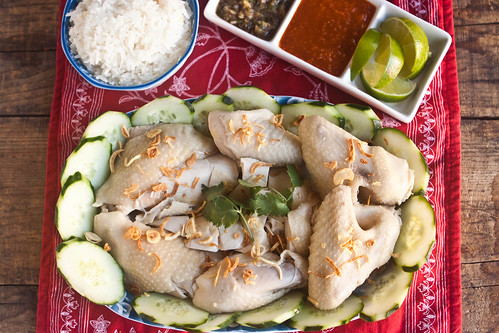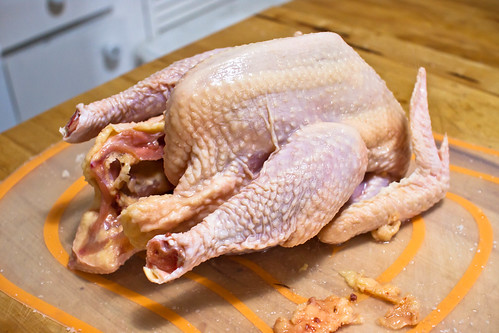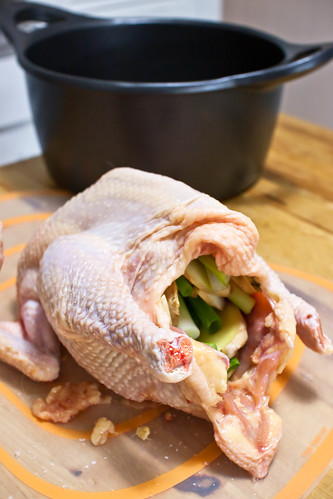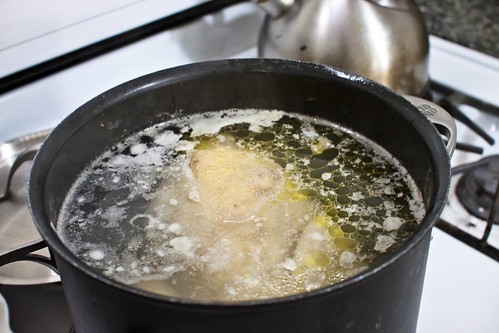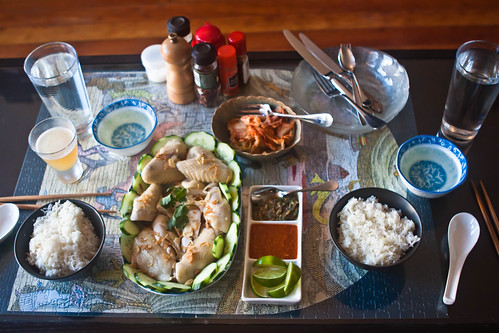It must have been the moment that I saw Flickr friend anakorpa’s photo of Hainanese Chicken Rice from Cafe D’lite in Vancouver that the cravings began.
Hainanese Chicken Rice is one of those seminal foods that I distinctly remember from my childhood. Silky slices of tender chicken, fragrant rice, clear gingery soup and the accompanying dipping sauces — this dish stands out as an early taste memory so pleasurable that it can make my mouth water even today.
It was a treat to go to the restaurant in Tradewinds – one of the Manila hotels in the upscale business district of Makati. Unfortunately, hardly a trace of this hotel, its restaurant or its menu can be found on the Internet today – but it existed, a while ago – back in the early 80s. I found one blog post that confirms it here – its author reminisces about the dish and her commenters also confirm the name and existence of the hotel and restaurant.
So why was Tradewinds so special? One went to Tradewinds just for the Hainanese Chicken Rice.
My memories are fuzzy and sometimes faint, but I do recall that the interior of the restaurant was vast, as many hotel eateries are, and dark and dim, the tables long and narrow, lit overhead by tiny white lights. The servers brought out our dishes on large wooden trays upon which were perched smaller wooden compartments of squarish / rectangular shape. I loved all the accoutrements – the largest platter of perfect, tasty boiled chicken, a perfectly round mound of fragrant rice, small boxes of the sauces, (I only touched the soy and the ginger-scallion), the square bowl of chicken soup in which floated bits of green onion and cilantro. I used to fish the cilantro out of the broth, and ladle some onto my rice. One horrible day, I accidentally overturned the entire contents of a glass of ice water onto my tray, soaking rice, soup, chicken, etc. I recall such a feeling of shock and loss – I don’t think my parents ended up ordering me another tray, but did portion out to me parts of their meals. I may also have gotten to finish what my little sister did not.
San Francisco is not awash with Singaporean or Malaysian eateries. We have the long-lasting Straits Cafe, but since its move to the Westfield Mall downtown several years ago, it seems much more interested in expanding its franchise and becoming a hip, darkly moodlit bass-techno-thumping gathering place for women in short skirts and 2-inch glittery nails and 3-inch spiked heels and their corresponding dates with the long-sleeved button-downs, untucked with jeans. DD and I tried their chicken rice a couple of years ago and were disappointed.
If I can’t find it easily in the Bay Area, why not attempt to make it myself? Thankfully, the interwebs are awash with helpful recipes, and I chose Steamy Kitchen’s version as my starting point.
I of course was shopping at my favourite nearby Asian supermarket — Sunset Super — and got to the chicken counter where signs are often darkly amusing. 3 kinds of whole chickens were on offer: “Vikon Chicken” at $8.99 each; an un-branded very white and plump “Headon Chicken” for $2.49/lb; and “Fresh Yellow Chicken” for $9.99 each. I didn’t know what Vikon chicken was, although I suppose I could have looked it up; in retrospect this would have been a good option as Vikons, it turns out, are heritage birds naturally and sustainably raised. When I asked the counter guy assisting me, however, which was the best whole chicken, he pointed to the most expensive one. Indeed, I noted that not only was it expensive, but its breasts even seemed considerably smaller and less plump than the “Headon Chicken” next to it in the case. I took this as a good sign and asked for one.
It came with its head on as well, and the counter guy would only chop it off for me after I had paid for the bird. Once I got home, however, I still had to use my newly-procured cleaver to hack off its long neck.
Ultimately Hainanese Chicken Rice is not hard to make – one rubs the bird down with kosher salt – this helps to clean and season the bird. Once you’ve rubbed the salt all over the chicken, sprinkle more salt on it, inside and out, to make sure it’s seasoned properly. Then, stuff whole lot of ginger and green onions into the bird’s cavity.
Fill a large pot with cool water and submerge your ginger-and-onion-stuffed chicken, leaving about one inch of water above the bird. Bring to a boil and then turn down to a simmer for about 30 minutes, or until a thermometer inserted into the thigh reads about 170F. Skim off the scum floating on the surface of the water.
After the chicken is just done, remove it from the pot and plunge it into an ice bath for about 10 minutes. (I took the photo after much of the ice had already melted.) This helps to ensure that the skin gets this amazing bouncy and firm consistency that’s so tasty.
While the chicken is cooking, of course, I prepped as much of the ingredients for the rice and sauce as I could, but you can only start completing these tasks when you have your chicken broth ready. I don’t have any photos from these sections but the procedure and ingredients for the rice and sauces are below.
Hainanese Chicken Rice, Adapted from Jess and Jaden Hair of Steamy Kitchen
Ingredients
Chicken
- 1 whole chicken – 2.5-3.5 lbs
- kosher salt
- 4″ knob of ginger, cut into 1/4″ coins
- 2-3 bunches of scallions, cut into 1″ lengths
Rice
- around 2-3 Tbs of chicken fat or vegetable oil
- 3 cups Jasmine rice, cleaned and rinsed
- 3-5 cloves of garlic, chopped fine
- 1-2″ knob of ginger, chopped fine
- 1 shallot, chopped fine
- 1 tsp sesame oil
- 2 generous pinches of kosher salt
- 3.5 cups of chicken poaching broth (I used the finger-measuring method to make sure I had added enough broth – 3.5 cups may not be enough)
Chile Sauce
- 4 Tbs sriracha chile sauce
- 4 cloves garlic, chopped
- 2 Tbs chicken poaching broth
- 2 tsp sugar
- 1 inch ginger, chopped
- 1 Tbs lime juice
- generous pinch of salt
Ginger Scallion Sauce, adapted from A Series of Kitchen Experiments:
- 2 stalks of green onion, chopped
- 2 tablespoons of soy sauce
- 1 tsp of sesame oil
- 3 cloves of garlic, chopped finely
- 2 Tbs of shallots, chopped finely
- 1″ knob of ginger, chopped finely
- 3 Tbs of chicken poaching broth
- 2 tsp of sugar, to taste
- dash of vegetable oil
Plating (optional)
- 1 medium sized cucumber, slightly peeled lengthwise so the outside looks striped, cut in thin slices on the diagonal
- cilantro leaves
- packaged fried shallots
Procedure
1) Place your chicken on a nice flat surface – probably on some sort of cutting board. Rub it all over with kosher salt, sloughing away loose bits of skin, fat and any other viscera. Scrub the inside of the chicken too. Once you think you’re done rubbing the chicken, sprinkle more salt all over, inside and out.
2) Stuff the chicken with ginger and scallions
3) Place the stuffed chicken into a stock pot pot and fill the pot with cold water – cover the chicken by one inch. You may find that you need to hold the chicken down in order to measure the inch of water above the bird. Bring the pot to a boil and then turn the heat down so it’s barely simmering. Cook for about 30 minutes, skimming off the foamy scum that rises to the top. (If you haven’t rubbed your chicken with salt prior to cooking you may find that the scum looks more brown than creamy-white.)
4) When the chicken is done cooking, remove the pot from the heat and carefully lift out the bird, being careful to avoid ripping the skin. Plunge the chicken into an ice bath and leave it to cool/ soak for about 10 minutes. After it’s cooled/ soaked, lift the bird onto your chopping block and rub it down with some sesame oil (I forgot to do this).
5) Prepare the rice: if you have chicken fat, render it a little with a little oil in your pan. If you’re not using the chicken fat (I forgot to use mine), heat up your vegetable and sesame oils and sautee the ginger, garlic and scallions until fragrant. Pour in the rice, and stir until the rice is well coated with the oils and aromatics.
6) Transfer the rice and aromatics to your rice cooker (note that Steamy Kitchen’s recipe has instructions for cooking rice in a regular pot – for those of you without rice cookers), add the broth, making sure it passes the finger test (if you stick your finger into the rice/ broth mixture, making sure your finger touches the top of the rice, the broth should come up to about 3/4″ of your finger). Cover the lid and cook until your cooker signals that the rice is done.
7) Make the sauces by blending the ingredients listed above in your blender or small food processor.
8) Chop up the chicken Asian style. I had of course never done this before and had to turn to YouTube for instructions. This video was the most useful. I still didn’t manage to be completely authentic, leaving the thigh and leg pieces whole and not quite managing to remove all of the breast. Still, a decent first attempt, methinks…
9) To plate, arange the chicken pieces attractively on a plate. Surround with cucumber slices and top with fried onion and cilantro. Serve the chicken with the rice, dipping sauces and a bowlful of the broth, seasoned as you like.
Variations/ Post-Cooking Thoughts
- Mark Bittman’s version – place the chicken into a boiling pot of water and cook over medium heat for 10 minutes. Then, turn the heat off, cover the pot and wait 45 minuted to an hour until the chicken is cooked through.
- Bittman’s prefacing article to the recipe above notes that some cooks freeze the leftover chicken poaching broth and use it as a starter for the next batch of chicken rice. Awesome.
- Steam the chicken topped with lots of ginger and scallion – and use only the legs.
- Use the chicken fat trimmed for the chicken as part of your starting sautee for the rice.
- Add more stuff to the brothe before serving – chopped scallion, tofu, soy sauce
- Make double of the Ginger-scallion Sauce above, and try using Sambal Oelek for the Chile sauce rather than Sriracha.
- As an alternate ginger-scallion sauce, chop up garlic, scallions and ginger (& shallots) fine, add salt, and pour hot oil over the mixture.
- Add some pandan leaves to the cooking rice water (if I can find some – think I might have seen some once in the Richmond New May Wah freezer case).
Other fun links:
- Top 10 Hainanese Chicken Rice Joints in Manila
- My friend Ben at Focus, Snap, Eat also recently made a version of poached Chicken Rice.
- My Flickr Photoset
